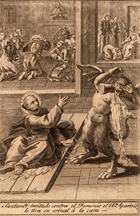| |

< click on image for enlargement >
|
Demons in 16th century Mexico.
"Santam[en]te. irritado contra el Demonio el Bto. Aparizio, le tira su orinal â la cara," Mateo Ximénez, Coleccion de estampas que representan los principales pasos, hechos y prodigios del Bto. Frai Sebastian de Aparizio, Rome, 1789.
Original in the John Carter Brown Library. |
|
The all too human life of a saintly man:
Sebastian de Aparacio
by Leslie Tobias Olsen
We generally think of the life of a saint being difficult—the temptations of sin, the denial of mortal flesh, and other acts of private, not to mention public, martyrdom. Further down on the list of difficulties for that saint is the posthumous difficulty of being anointed a saint by the Catholic Church. The putative, and alas deceased, saint’s claim is often forwarded by writers who describe the candidate’s virtuous works and miracles.
One of the more interesting of these hagiographies is Mateo Ximénez’s Coleccion de estampas que representan los principales pasos, hechos y prodigios del Bto. Frai Sebastian de Aparizi, Rome, 1789. A sort of early precursor of a graphic novel, it shows many important scenes from the good Aparicio’s life (over 120 images!). Sebastián de Aparicio was born in Spain in 1502 and made his fortune in Mexico in the transportation business; he joined the Franciscans as a lay brother when he was 70 and was beatified in 1787. He died in 1600. He never made it any further on the sainthood ladder (his two marriages–even though reportedly chaste–worked against his application). The book, in addition to reporting on Aparacio's saintly life, shows ordinary life in eighteenth-century Mexico [or more probably Italy or Spain] beautifully–the older novitiate hoeing his cabbages in a monastic garden, the humble family receiving guests into their farmhouse, a man sheltering under a cart during a snow storm [in Mexico?].
The book also illustrates a vivid struggle of man battling the forces of evil in the world as demonstrated by the image above. Aparicio was sorely tempted by demons who pestered him continually. One large one bothers him even as he lies in humility on his bed of planks! These devils show no mercy. To reveal how very tormented Aparacio was—and also how very human—he is shown here throwing the urine in his chamber pot at a particularly annoying demon. The contents splash on the winged beast, surprising it greatly. And in the background, Aparicio is shown confessing his sin of exasperation to his abbot and scourging himself in expiation of his sin.
It is these little details of humanity which make a book such as this so appealing. All the images from this book may be seen on the JCB's Archive of Early American Images. |


